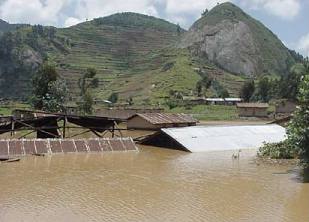Flood and drought management
Floods and drought cause severe damage and costs to the Rwandan society. Economic costs of the 2007 flood were over $20 million in 2 regions (around 0.1 – 0.6% of GDP). With ongoing land degradation and higher rainfall intensities due to climate change and larger investments due to economic development, a 5-fold increase in costs related to disaster is expected by 2030. 1 million people were affected by the 2005/6 drought. In other words, river floods, flash floods, landslides and droughts are serious risks for doing business. Without flood management mitigation actions the land degradation, floods and droughts will intensify and cause increasing damage.
MIDIMAR the Ministry of Disaster Management and Refugee Affairs plays a crucial role in disaster management. Contingency plans for droughts and floods and landslides contain measures for: preparedness, for responses and for recovery after disaster. These are actions that aim to limit the impact of the disaster.
The aim of IWRM is a more structural approach to disaster mitigation and living with water. IWRM provides the framework to reduce the frequency and impact of water related disasters. Proper drought and flood management planning and implementation reduces the risk and the damage of disasters in the future.
Managing droughts and floods is more than technical interventions it require above all a culture of: a)prevention by managing flood and drought risks b) living with floods and droughts. This requires is a different mindset and behavior of the decision makers, the engineers, farmers and the population.

Integrated flood management aims to maximize the benefits from normal flood waters that provide freshwater, nutrients and sediments, while minimizing loss of life and the impact on livelihoods due to the occurrence of extreme events. Integrated flood management is about adopting a best mix of measures throughout the catchment, to reduce flood risk and mitigate the consequences once a flood occurs. Plans include measures to increase water retention and infiltration, upstream forestation, agro-forestry, river border protection with gabion walls or bio-tecnic measures, levees, storage ponds, wetlands, bridges and drainage infrastructure, enlargement and trimming of the river course. Not less important are policies and policy enforcement and behaviour change for compliance with buffer zone regulation and keeping waterways clean.
Flood and drought management is as much about farmers applying contour ploughing as about building large scale dams. Drought and flood management partly overlap. Dams can function as flood control during the rainy season and are drought measure during the dry season. IWRM aims to adapt the design to address multiple purposes; i.e. a dam for flood control that stores water for irrigation and drinking water, produces fish and is made beautiful to create value for leisure.
Monitoring and forecasting of meteorological and hydrological data feeds into early warning systems to predict and anticipate drought and floods. This is important to reduce the level of damage and respond quickly once calamities strike. Being proactive to drought management requires continuous monitoring of indicators to help predict the onset and extent of drought, as well as to help determine when to relax restrictions and return to normal operations.
Further reading:
MIDIMAR disaster maps: Casualties from disaster
MIDIMAR National plan for drought and floods
World Resources Institute Flood risk global map/Rwanda
IUCN Helping nature help us.Transforming disaster risk reduction through ecosystem management 2016.
Association Programme of Flood Management Flood management tools
Association Programme of Flood Management Strategies and Measures for integrated flood management GWP.
Integrated Drought Management Programme Benefits of action and inaction in drought management
Integrated Drought Management Programme Building resilience to drought: learning from experience in the Horn of Africa
Design criteria for drought and flood management infrastructures for Rwanda
River bank protection: Stream/River Bank Management
An example multi-purpose dam Powerpoint presentation Muvumba
